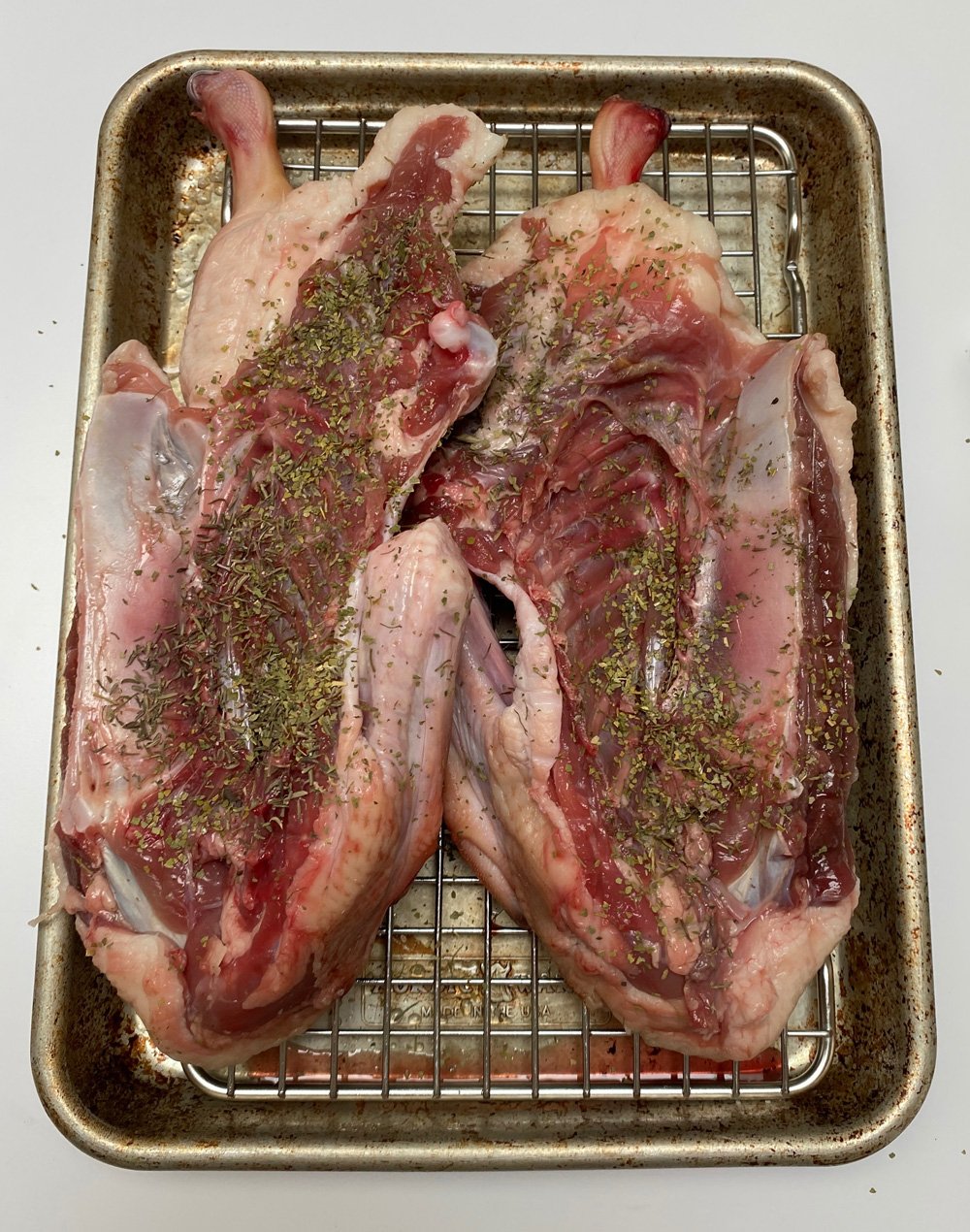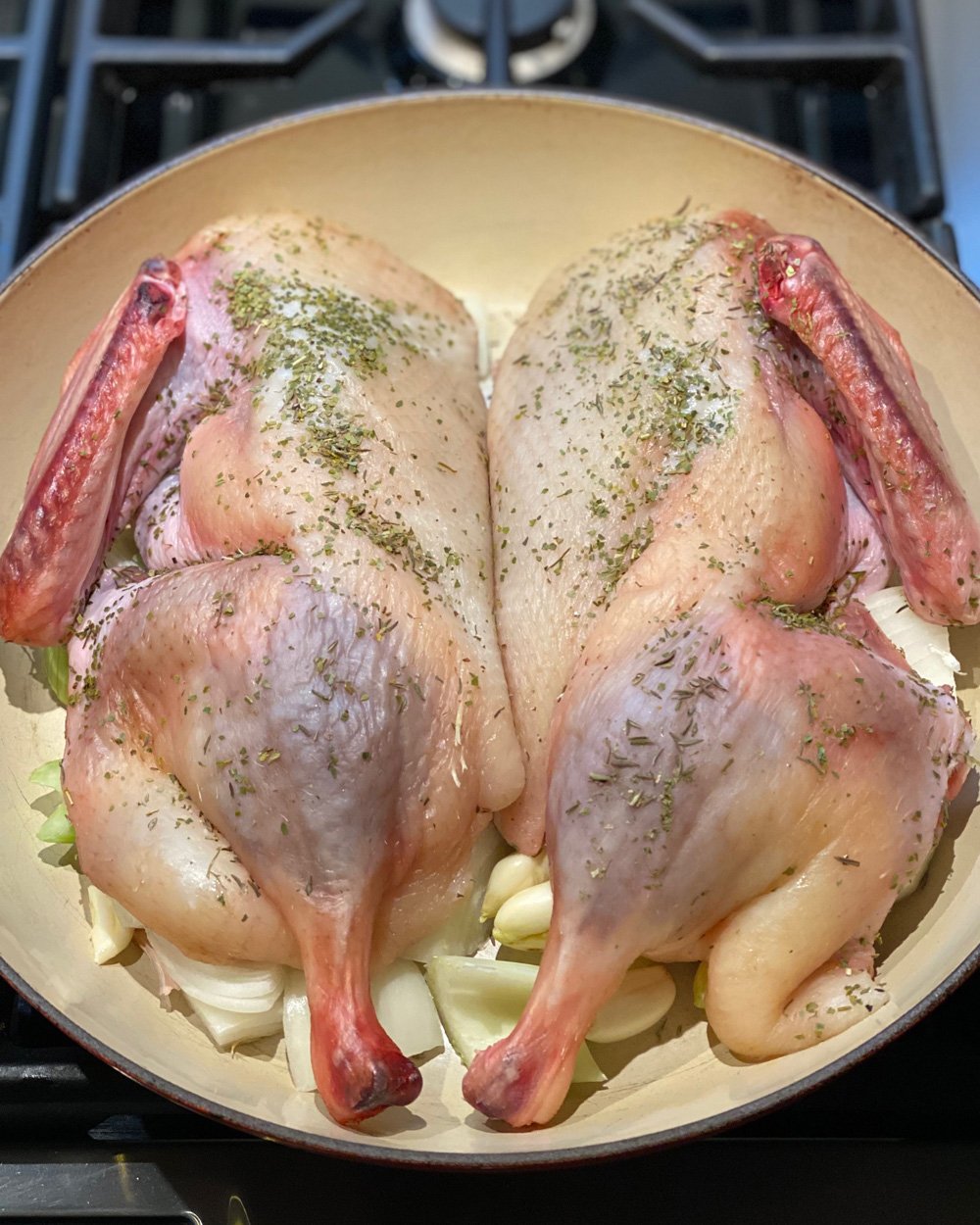Slow cooked duck Method
Cannard Rôti
Slow roasted Duck
A savory lovely dish
What a lovely savory dish that seems to be perfect every time. This method of cooking duck came after I made a slow roasted Duck with Green Olives in Provence. I wanted to perfect the recipe once I came back to Portland. But here in Portland, I made a wild mushroom sauce instead of a green olive sauce, and a demi-glace, which is simply divine!
Now that I’ve cooked it a few times and perfected my method, a few people have said it was simply the best duck they’ve ever had. Lucky for you, I’m including my method below. My “recipes” are methods. Because everyone and their kitchens are different, you may need to alter things for your own preference.
The ingredients for a slow roasted duck with green olives. I made this in Provence. See my blog here.
cannard Rôti
Slow Roasted duck recipe guide
This is a guide of what I did. All ingredients are an approximate. I take notes, but I don’t measure. I go by my experience, so you’ll have to trust yourself a little here. First you’ll see how to prepare the duck, then the sauce below.
ingredients for roasting the duck
Roasting the duck:
One whole duck around 5 1/2 pounds
1 large onion chopped into large chunks
1 leek cut into large slices
one whole garlic head, with the cloves separated
3 bay leaves
1 celery rib sliced into large chunks
thyme sprigs
kosher salt
herbs of choice - the list can go on and on. Here are some ideas..
herbs de provence
thyme chervil, crushed bay leaves (pictured above)
coriander star anise, juniper berries, pepper (perfect for a fall dish)
Preparing the duck
One of the most important steps to make sure to have a moist duck is to salt, then air dry it.
Three days before, cut the duck in half.
Cut the neck off if still attached and trim the extra skin and fat from the cavities. Reserve for stock.
Cut the wing tips off and reserve for stock.
Cut the back bone out with a sharp knife or poultry shears. Reserve for stock.
Break the top chest bone and cut the breast bone right down the middle with sharp poultry shears. Keep the bones intact.
Wash off any possible blood, liver or kidneys that may be attached.
Dry with a paper towel.
Salt both sides generously with kosher salt. (not too much, you will not remove the salt later as one would with confit).
Place on a rack on a baking sheet and put in the refrigerator uncovered for at least two full days, or three days.
The Day of the dinner
Early in the day…
In the morning…
Take the duck out and prick all over through the skin and fat with a sharp knife tip. Try avoiding puncturing the actual meat.
Season both sides with herbs. Above I used thyme, chervil and laurier (bay leaves in which I bring back from France since they are soft and nicely crushed. I can’t find them here in the US that way).
Put back in the refrigerator until two to three hours before you want to cook it.
Roast the duck
Take the duck out of the refrigerator between 2 to 3 hours before you are ready to cook it.
Pre-heat the oven to 475F convection.
Put all of the chunks of the aromatics (onion, leek, celery, garlic, bay leaves and herbs) into a braising pan. This will not only infuse the duck, but help the duck stay above all of the fat drippings.
Place the duck halves on top of the aromatics skin up. Roast uncovered for 10 minutes.
Take duck out of the oven, prick the skin more if needed. (It’s important to allow the fat to drip over continuously for basting as well as releasing so the duck doesn’t taste “fatty”).
Reduce the oven to 250 bake (no convection).
Cover the duck with lid (or foil) and bake for 3 hours. The internal temp should be around 200 F. It’s fine if it’s a little over.. perfect!
Finalizing the duck
After the duck has cooked for three hours the meat temperature should be around 200 degrees F. Mine was at 205.
Take the duck out of the oven after 3 hours.
Remove the duck from the pan and cover tightly with foil or a lid.
Let duck rest for up to 2 hours.
Once cool enough to handle, cut each duck half into two pieces along the breast line. You should have two pieces, one with the breast and wing, the other is the whole hind leg. Remove the rib bones from the breast.
When ready to plate up and serve. Put the duck under a broiler for 5 minutes until crispy and brown.
Add braising drippings to your sauce
The braising liquid is half fat and half flavored drippings that will add a nice quality to your sauce. The trick is only adding the flavored drippings, and not the fat.
Strain the liquid through a sieve into a bowl or small pot and discard the solids. Put the bowl or pot in the freezer to quickly separate the fat from the dark drippings. If you have enough time, the fat will firm up making it easy to spoon the fat off leaving you with the lovely drippings underneath.
If you don’t have enough time for the fat to firm up, still put it in the freezer or refrigerator and you’ll see the fat will rise to the top. You can either spoon off all of the fat, or use a baster to pull out the pan juices.
Put the pan juices in a pan and simmer down until you like the consistency. You can add this to your sauce.
A Sauce
After rendering the fat, basically make a rich duck stock. You have many options here. You can simply make a normal duck stock, then put the strained stock in a pot and cook until it’s a rich demi-glace. This is the best! But if you want a thinner sauce and a lot of it, here is a good sauce.
Render the fat.
Put all of the fatty parts of the duck trimming into a thick pan on the lowest heat possible for about 30 minutes to an hour. Keep a close eye on it so you don’t brown the fat. Once you feel like the majority of the fat has been rendered, drain the fat and reserve for another use.In a large pot, add one to two tablespoons of the duck fat. Then add the bones and the strained fatty parts along with the onion quarters over medium heat. Brown them turning regularly.
Add the celery, carrots and leeks mixing for a couple of minutes. Add the tomato paste swirling around for a minute. Add some of the wine and scrape up any bits on the pan. Then add the rest of the wine and bring to a boil. Then add enough water to cover the vegetables, about 5 cups. Add bay leaves, parsley sprigs and peppercorns. Simmer uncovered for a little while and skim the foam off of the top every few minutes. Then cover and simmer low for around three hours.
Once you feel like the stock has absorbed the flavors of the bones and vegetables, strain the sauce and discard the solids. Heat the strained sauce on low heat and skim off any fat or impurities that rise to the top. I use a spoon in a crock of water next to the stove for easy and quick cleaning of the spoon. This process can take anywhere from 20 to an hour. If you want the sauce really thick, like a deme-glace, than it takes a while. Get close to the consistency that you like then turn off heat, cover and reserve.
Add french green olives at the end -or- sautéd wild mushrooms. And finally add sherry vinegar to finish the flavor profile.























